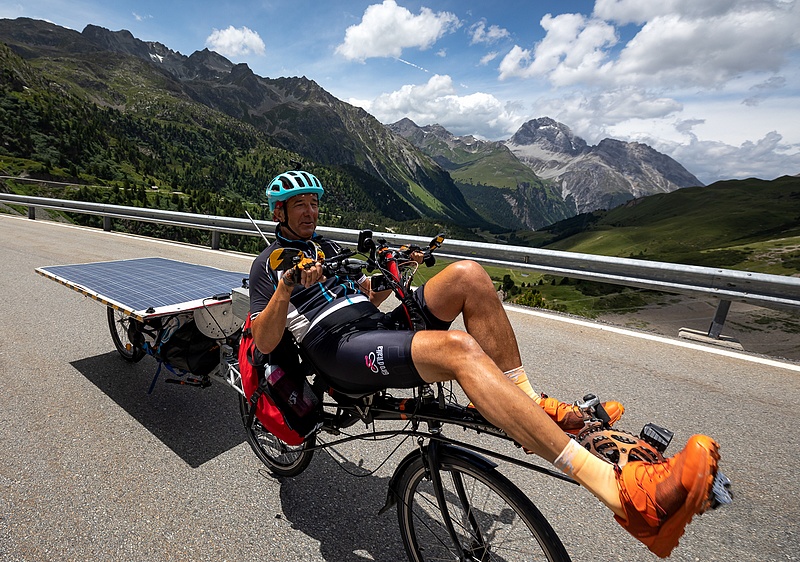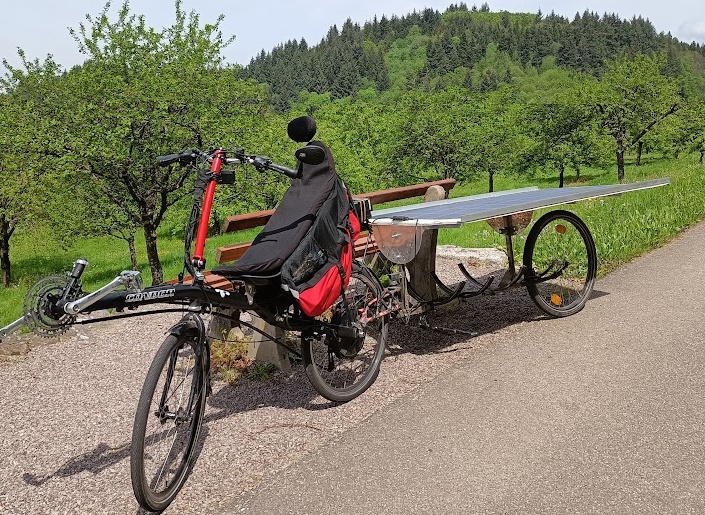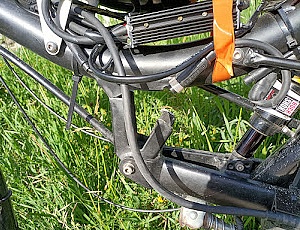
© Photo Etienne Ramousse – Agence Zeppelin – D.R.
Introduction
I started the solar bike with a recumbent bike bought second-hand. I motorized it with a 1000W direct drive motor and the battery was made with user elements (for recycling purposes) with a power of 1000W in 48 volts.
The solar panel with a power of 200W was also used and I mounted it on a single-wheel trailer made by myself using old bikes.
My goal was to make solar with a "recycling" spirit, an ecological goal….
First observation, I started my work in March for a departure in June and it was fair in terms of time because the making of the trailer took me a lot of time.
Technical description
Bicycle
The bike itself: No particular difficulties, the recumbent bike is a very good compromise when you do very long distance. Practicing the standing muscle bike, I felt the difference by the disappearance of pain both in the cervical, back and glutes. None of that with a recumbent bike.

The only downside for this style of bike is the climbs that are more difficult to manage hence the addition of a particularly useful engine.
Motorization
The engine
I had been advised for this point and a direct drive wheel motor was offered to me. This engine placed in the rear wheel is interesting in terms of longevity as well as in terms of energy backup during braking and downhill because it brings regeneration.
I bought a Direct Drive wheel motor on the rear wheel. The big problem with this engine is that uphill, you have to drive at the minimum speed of 12 km/h otherwise there is a risk of deterioration of the controller or decrease in its efficiency (depending on the model of controller used).
If this speed of 12 km/h can be held on a short climb, it is not the same in the ascent of a pass: I had to stop often to let the whole thing cool down, which was a handicap. So on a hilly course, the solution is good but on a mountain course, I will not advise it or at least not if it relies on a single engine. Otherwise regeneration is really very interesting in terms of additional energy.
The controller
He gave me a lot of trouble because the manufacturer, victim of the shortage of electronic parts, had not put the right elements and provided what he had. Consequence: a first breakage leading to the replacement by a controller of lower quality, which dropped in the Wurtzle pass. The 2nd replacement was done with a controller who finally did his job. I do not provide the name of the supplier of these controllers because their failure was not his fault but that of their manufacturer. A special mention to Décic Eco who invested so that I could continue my trip.
Battery
I made it from recycled elements, there was no problem with it.
Solar panels
On the solar panel side, there is food and drink in terms of quality and price. My 200W panel gave me satisfaction but as it was a little old, I rarely observed a production at 200W.
Trailer
I made it with two bike frames. The panel served as a kind of roof and underneath, I had placed my bag which was placed on pieces of cut bike rims (this last system is very interesting). This steel trailer was quite heavy and I hooked it to the bike on the axle of the rear wheel.

In terms of stability it did its job but the hanging solution causes quite strong stresses on the frame at the level of the swingarm. This is why I will recommend hanging the trailer at the level of the saddle so as not to have these constraints.
Indeed these constraints caused a severe deterioration of the frame which led to the breakage of the latter at the level of the leg that holds the swingarm to the frame, hence a sudden stop of my trip.
The future
My next bike will still be a recumbent bike equipped with 2 motors. I will abandon the trailer and place the solar panels on the roof. The absence of a trailer will limit the amount of luggage and this will avoid unnecessarily weighing down your bike.
